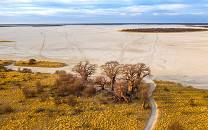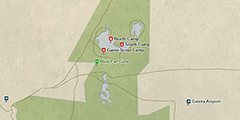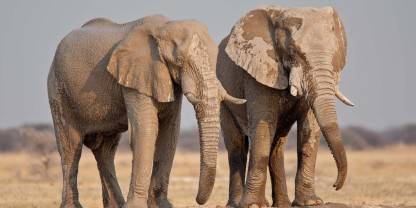Nxai Pan National Park is a compact place with a wonderful range of habitats and good (if seasonal) wildlife viewing. It forms part of the larger ecosystem that also takes in Makgadikgadi Pans National Park. Unlike Makgadikgadi’s salt-encrusted pans, Nxai Pan is a dry fossil pan covered in grass and dotted with acacia islands. It has a charm all its own. The area comes to life after the summer rains in December, when migrating zebra and wildebeest arrive to feast on the new grasses.

-
Best Time To Go
- December to March (Best wildlife viewing)
-
High Season
- December to May (Higher rates apply but it’s not busy)
-
Size
- 2,100km² / 811mi²
-
Altitude
-
914-953m /2,999-3,127ft
 View Photos
View Photos
 View Photos
+17
Photos
View Photos
+17
Photos
 Open Map
Open Map
Pros & Cons
- Stunning desert scenery of the northern Kalahari
- Off the beaten track and never crowded
- Open plains make wildlife viewing easier
- Animals migrate to the pan in the wet summer months
- Less wildlife than in more popular parks, such as Chobe National Park or Moremi Game Reserve
- Very few accommodations in and outside the park
- Daytime temperatures can be very hot and dry in winter
Wildlife
After the first good rains, usually around November or December, this is the best place (after neighboring Makgadikgadi Pans National Park) to see one of southern Africa’s most amazing wildlife spectacles: the migration of tens of thousands of zebra, from December to March. Smaller herds of giraffe, impala, springbok, oryx and red hartebeest can also be seen. There are always some elephants around, and lions are resident, if not always spotted.
More about Nxai Pan’s wildlifeScenery
Nxai Pan is the more accessible of the pans in the area, and it’s a fascinating place to explore. Nxai Pan is among the oldest of the Kalahari pans. Permanent grasses have taken root and pockets of acacia trees grow inside the pan or in thick stands of acacia woodlands. Some huge baobab trees tower on the fringes. After the rains, the pans are covered in spring flowers.
Activities
Guided or self-guided are the only activities allowed within the park’s boundaries. These provide many wonderful opportunities for bird watching or looking for wildlife, and you’ll rarely have to share sightings with too many other vehicles. Pick up a map from the park entrance on your way into the park.
Weather & Climate
Nxai Pan’s desert locale is governed by a distinct pair of seasons: the Dry (April to October) and the Wet (November to March). The sunny, warm days at the start of the drier months give way to cooler midyear conditions before the heat builds in the lead-up to the first rains of November. The Wet season typically doesn’t see day after day of rain. Instead, afternoon thunderstorms are the norm.
More about the weather and climateBest Time To Visit
You can explore Nxai Pan year-round. But don’t expect to see much wildlife in the Dry season (April to October), when animals venture elsewhere in search of water and to escape the constant dust. For the richest animal-watching experiences, visit after the rains have arrived, from December to March, when wildebeest, zebra and many other species come here to drink. You’ll also see plenty of greenery, including flowers.
More about the best time to visit



